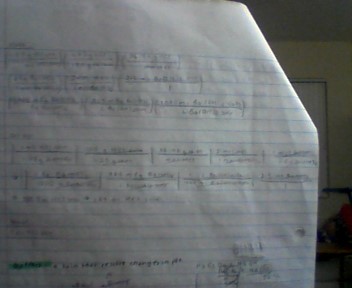How many #"mL"# of #1.25%# (by mass) #"HCl"# would be required to neutralize #"215 mL"# of #"325 mEq/L"# #"Ba"("OH")_2#?
Assume all solutions have a density of 1.08 g/mL.
Note: My issue is understanding how to apply equivalents (unit Eq) to acids and bases. With singular elements/molecules, I understand, but not compounds.
Assume all solutions have a density of 1.08 g/mL.
Note: My issue is understanding how to apply equivalents (unit Eq) to acids and bases. With singular elements/molecules, I understand, but not compounds.
2 Answers
The volume needed is
Since we used equivalents, we don't need to worry about mol ratios here, but had we used mols instead, we would.
Equivalents are defined with respect to the
Suppose you have
Here you have
#(325 cancel("mEq Ba"("OH")_2))/"L" xx (2 cancel"milli""mol OH"^(-))/(2 cancel("mEq Ba"("OH")_2)) xx (1 cancel"thing")/(1000 cancel"milli"cancel"things")#
#= "0.325 M OH"^(-)# in solution
Exact neutralization requires the same number of
#"Ba"("OH")_2(aq) + 2"HCl"(aq) -> 2"H"_2"O"(l) + "BaCl"_2(aq)#
#"0.325 mol OH"^(-)/cancel"L" xx 0.215 cancel"L" = "0.0699 mols OH"^(-)#
Based on the balanced chemical reaction,
This number of mols can be contained in any volume of solution, but we specify that the concentration available is:
#"1.25 % by mass" = ("1.25 g HCl")/("100 g solution")# (the solution volume is exact, being a definition of percent, so it has infinite sig figs.)
Using the density of the solution, we can convert this molarities, since we have
I would treat the numerator and denominator separately:
NUMERATOR
#1.25 cancel"g HCl" xx ("1 mol HCl")/(36.461 cancel"g HCl")#
#=# #"0.0343 mols HCl"# (in#"100 g solution"# )
DENOMINATOR
#100 cancel"g solution"xx overbrace(cancel"1 mL solution"/(1.08 cancel"g solution"))^("density = 1.08 g/mL") xx "1 L"/(1000 cancel"mL")#
#=# #"0.0926 L solution"#
Therefore, the solution molarity is:
#["HCl"] = "0.0343 mols HCl"/"0.0926 L solution" = "0.370 M"#
Finally, we can use this concentration to see how much volume is needed to contain
#color(blue)(V_(HCl(aq))) = 0.0699 cancel"mols HCl" xx "L"/(0.370 cancel"mol HCl")#
#=# #"0.189 L"#
#=# #color(blue)("189 mL")#
This should make sense, because the molar concentration of
So, it's good that we got LESS than

Explanation:
#=188.9\text( mL )HCl(soln)\rArr189\text( mL )HCl(soln)#


